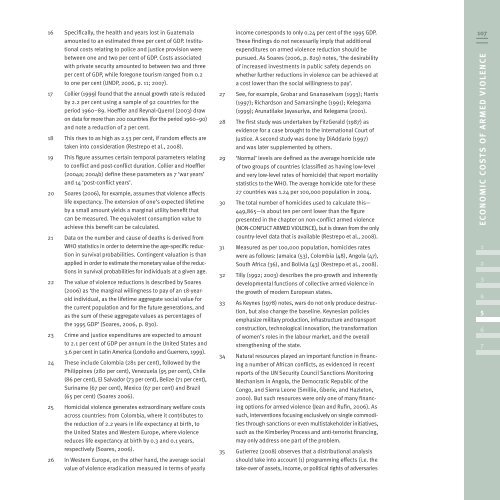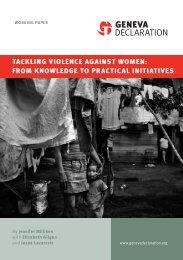Global Burden of Armed Violence - The Geneva Declaration on ...
Global Burden of Armed Violence - The Geneva Declaration on ...
Global Burden of Armed Violence - The Geneva Declaration on ...
Create successful ePaper yourself
Turn your PDF publications into a flip-book with our unique Google optimized e-Paper software.
16 Specifically, the health and years lost in Guatemala<br />
amounted to an estimated three per cent <str<strong>on</strong>g>of</str<strong>on</strong>g> GDP. Instituti<strong>on</strong>al<br />
costs relating to police and justice provisi<strong>on</strong> were<br />
between <strong>on</strong>e and two per cent <str<strong>on</strong>g>of</str<strong>on</strong>g> GDP. Costs associated<br />
with private security amounted to between two and three<br />
per cent <str<strong>on</strong>g>of</str<strong>on</strong>g> GDP, while foreg<strong>on</strong>e tourism ranged from 0.2<br />
to <strong>on</strong>e per cent (UNDP, 2006, p. 11; 2007).<br />
17 Collier (1999) found that the annual growth rate is reduced<br />
by 2.2 per cent using a sample <str<strong>on</strong>g>of</str<strong>on</strong>g> 92 countries for the<br />
period 1960–89. Hoeffler and Reynal-Querol (2003) draw<br />
<strong>on</strong> data for more than 200 countries (for the period 1960–90)<br />
and note a reducti<strong>on</strong> <str<strong>on</strong>g>of</str<strong>on</strong>g> 2 per cent.<br />
18 This rises to as high as 2.53 per cent, if random effects are<br />
taken into c<strong>on</strong>siderati<strong>on</strong> (Restrepo et al., 2008).<br />
19 This figure assumes certain temporal parameters relating<br />
to c<strong>on</strong>flict and post-c<strong>on</strong>flict durati<strong>on</strong>. Collier and Hoeffler<br />
(2004a; 2004b) define these parameters as 7 ‘war years’<br />
and 14 ‘post-c<strong>on</strong>flict years’.<br />
20 Soares (2006), for example, assumes that violence affects<br />
life expectancy. <str<strong>on</strong>g>The</str<strong>on</strong>g> extensi<strong>on</strong> <str<strong>on</strong>g>of</str<strong>on</strong>g> <strong>on</strong>e’s expected lifetime<br />
by a small amount yields a marginal utility benefit that<br />
can be measured. <str<strong>on</strong>g>The</str<strong>on</strong>g> equivalent c<strong>on</strong>sumpti<strong>on</strong> value to<br />
achieve this benefit can be calculated.<br />
21 Data <strong>on</strong> the number and cause <str<strong>on</strong>g>of</str<strong>on</strong>g> deaths is derived from<br />
WHO statistics in order to determine the age-specific reducti<strong>on</strong><br />
in survival probabilities. C<strong>on</strong>tingent valuati<strong>on</strong> is than<br />
applied in order to estimate the m<strong>on</strong>etary value <str<strong>on</strong>g>of</str<strong>on</strong>g> the reducti<strong>on</strong>s<br />
in survival probabilities for individuals at a given age.<br />
22 <str<strong>on</strong>g>The</str<strong>on</strong>g> value <str<strong>on</strong>g>of</str<strong>on</strong>g> violence reducti<strong>on</strong>s is described by Soares<br />
(2006) as ‘the marginal willingness to pay <str<strong>on</strong>g>of</str<strong>on</strong>g> an 18-yearold<br />
individual, as the lifetime aggregate social value for<br />
the current populati<strong>on</strong> and for the future generati<strong>on</strong>s, and<br />
as the sum <str<strong>on</strong>g>of</str<strong>on</strong>g> these aggregate values as percentages <str<strong>on</strong>g>of</str<strong>on</strong>g><br />
the 1995 GDP’ (Soares, 2006, p. 830).<br />
23 Crime and justice expenditures are expected to amount<br />
to 2.1 per cent <str<strong>on</strong>g>of</str<strong>on</strong>g> GDP per annum in the United States and<br />
3.6 per cent in Latin America (L<strong>on</strong>doño and Guerrero, 1999).<br />
24 <str<strong>on</strong>g>The</str<strong>on</strong>g>se include Colombia (281 per cent), followed by the<br />
Philippines (280 per cent), Venezuela (95 per cent), Chile<br />
(86 per cent), El Salvador (73 per cent), Belize (71 per cent),<br />
Suriname (67 per cent), Mexico (67 per cent) and Brazil<br />
(65 per cent) (Soares 2006).<br />
25 Homicidal violence generates extraordinary welfare costs<br />
across countries: from Colombia, where it c<strong>on</strong>tributes to<br />
the reducti<strong>on</strong> <str<strong>on</strong>g>of</str<strong>on</strong>g> 2.2 years in life expectancy at birth, to<br />
the United States and Western Europe, where violence<br />
reduces life expectancy at birth by 0.3 and 0.1 years,<br />
respectively (Soares, 2006).<br />
26 In Western Europe, <strong>on</strong> the other hand, the average social<br />
value <str<strong>on</strong>g>of</str<strong>on</strong>g> violence eradicati<strong>on</strong> measured in terms <str<strong>on</strong>g>of</str<strong>on</strong>g> yearly<br />
income corresp<strong>on</strong>ds to <strong>on</strong>ly 0.24 per cent <str<strong>on</strong>g>of</str<strong>on</strong>g> the 1995 GDP.<br />
<str<strong>on</strong>g>The</str<strong>on</strong>g>se findings do not necessarily imply that additi<strong>on</strong>al<br />
expenditures <strong>on</strong> armed violence reducti<strong>on</strong> should be<br />
pursued. As Soares (2006, p. 829) notes, ‘the desirability<br />
<str<strong>on</strong>g>of</str<strong>on</strong>g> increased investments in public safety depends <strong>on</strong><br />
whether further reducti<strong>on</strong>s in violence can be achieved at<br />
a cost lower than the social willingness to pay’.<br />
27 See, for example, Grobar and Gnanaselvam (1993); Harris<br />
(1997); Richards<strong>on</strong> and Samarsinghe (1991); Kelegama<br />
(1999); Arunatilake Jayasuriya, and Kelegama (2001).<br />
28 <str<strong>on</strong>g>The</str<strong>on</strong>g> first study was undertaken by FitzGerald (1987) as<br />
evidence for a case brought to the Internati<strong>on</strong>al Court <str<strong>on</strong>g>of</str<strong>on</strong>g><br />
Justice. A sec<strong>on</strong>d study was d<strong>on</strong>e by DiAddario (1997)<br />
and was later supplemented by others.<br />
29 ‘Normal’ levels are defined as the average homicide rate<br />
<str<strong>on</strong>g>of</str<strong>on</strong>g> two groups <str<strong>on</strong>g>of</str<strong>on</strong>g> countries (classified as having low-level<br />
and very low-level rates <str<strong>on</strong>g>of</str<strong>on</strong>g> homicide) that report mortality<br />
statistics to the WHO. <str<strong>on</strong>g>The</str<strong>on</strong>g> average homicide rate for these<br />
27 countries was 1.24 per 100,000 populati<strong>on</strong> in 2004.<br />
30 <str<strong>on</strong>g>The</str<strong>on</strong>g> total number <str<strong>on</strong>g>of</str<strong>on</strong>g> homicides used to calculate this—<br />
449,865—is about ten per cent lower than the figure<br />
presented in the chapter <strong>on</strong> n<strong>on</strong>-c<strong>on</strong>flict armed violence<br />
(NON-CONFLICT ARMED VIOLENCE), but is drawn from the <strong>on</strong>ly<br />
country-level data that is available (Restrepo et al., 2008).<br />
31 Measured as per 100,000 populati<strong>on</strong>, homicides rates<br />
were as follows: Jamaica (53), Colombia (48), Angola (47),<br />
South Africa (36), and Bolivia (43) (Restrepo et al., 2008).<br />
32 Tilly (1992; 2003) describes the pro-growth and inherently<br />
developmental functi<strong>on</strong>s <str<strong>on</strong>g>of</str<strong>on</strong>g> collective armed violence in<br />
the growth <str<strong>on</strong>g>of</str<strong>on</strong>g> modern European states.<br />
33 As Keynes (1978) notes, wars do not <strong>on</strong>ly produce destructi<strong>on</strong>,<br />
but also change the baseline. Keynesian policies<br />
emphasize military producti<strong>on</strong>, infrastructure and transport<br />
c<strong>on</strong>structi<strong>on</strong>, technological innovati<strong>on</strong>, the transformati<strong>on</strong><br />
<str<strong>on</strong>g>of</str<strong>on</strong>g> women’s roles in the labour market, and the overall<br />
strengthening <str<strong>on</strong>g>of</str<strong>on</strong>g> the state.<br />
34 Natural resources played an important functi<strong>on</strong> in financing<br />
a number <str<strong>on</strong>g>of</str<strong>on</strong>g> African c<strong>on</strong>flicts, as evidenced in recent<br />
reports <str<strong>on</strong>g>of</str<strong>on</strong>g> the UN Security Council Sancti<strong>on</strong>s M<strong>on</strong>itoring<br />
Mechanism in Angola, the Democratic Republic <str<strong>on</strong>g>of</str<strong>on</strong>g> the<br />
C<strong>on</strong>go, and Sierra Le<strong>on</strong>e (Smillie, Gberie, and Hazlet<strong>on</strong>,<br />
2000). But such resources were <strong>on</strong>ly <strong>on</strong>e <str<strong>on</strong>g>of</str<strong>on</strong>g> many financing<br />
opti<strong>on</strong>s for armed violence (Jean and Rufin, 2006). As<br />
such, interventi<strong>on</strong>s focusing exclusively <strong>on</strong> single commodities<br />
through sancti<strong>on</strong>s or even multistakeholder initiatives,<br />
such as the Kimberley Process and anti-terrorist financing,<br />
may <strong>on</strong>ly address <strong>on</strong>e part <str<strong>on</strong>g>of</str<strong>on</strong>g> the problem.<br />
35 Gutierrez (2008) observes that a distributi<strong>on</strong>al analysis<br />
should take into account (1) programming effects (i.e. the<br />
take-over <str<strong>on</strong>g>of</str<strong>on</strong>g> assets, income, or political rights <str<strong>on</strong>g>of</str<strong>on</strong>g> adversaries<br />
107<br />
ECO N OMIC COS T S OF A R M E D V I O L E N C E<br />
1<br />
2<br />
3<br />
4<br />
5<br />
6<br />
7









